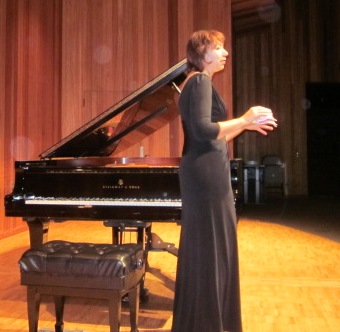|
Symphony
FROM THE NEW WORLD TO THE OLD WORLD
by Peter Lert
Saturday, June 14, 2025
Chamber
MC2 DUO RECITAL CLOSES 222'S SEASON
by Terry McNeill
Saturday, June 14, 2025
Choral and Vocal
CANTIAMO SONOMA'S LUSCIOUS A CAPELLA SINGING IN SEASON ENDING CONCERT
by Pamela Hicks Gailey
Sunday, June 8, 2025
Symphony
SRS SEASON ENDS WITH RESOUNDING TA-TA-TA-BANG
by Terry McNeill
Sunday, June 1, 2025
Symphony
YOUTHFUL VIRTUOSITY ON DISPLAY AT USO'S MAY CONCERTS
by Peter Lert
Saturday, May 17, 2025
Symphony
MYSTICAL PLANETS AND LIVELY GERSHWIN ORTIZ AT FINAL SRS CONCERT
by Peter Lert
Sunday, May 4, 2025
Symphony
VSO'S CONCERT MUSIC OF TIME, MUSIC OF PLACE
by Peter Lert
Sunday, April 27, 2025
VOCAL ELEGANCE AND FIRE AT THE 222'S RECITAL APRIL 26
by Pamela Hicks Gailey
Saturday, April 26, 2025
CANTIAMO SONOMA SINGS AN INSPIRED GOOD FRIDAY MOZART REQUIEM CONCERT
by Pamela Hicks Gailey
Friday, April 18, 2025
DRAMATIC SHOSTAKOVICH SYMPHONY CLOSES PHILHARMONIC'S 25TH SEASON
by Terry McNeill
Sunday, April 13, 2025
|
 |
 Elena Kuschnerova in Newman Auditorium Nov. 20 |
PASSIONATE SCHUMANN AND POETIC TCHAIKOVSKY IN ELENA KUSCHNEROVA PIANO RECITAL
by Terry McNeill
Sunday, November 20, 2011
Danish virtuoso Egon Petri once commented that most pianists “spend their melodic purse in small coin.” Elena’s Kuschnerova, in her second Concerts Grand appearance Nov. 20, would have none of that approach, playing a mercurial recital that left nothing on the table in the wake of her potent musical personality.
In SRJC’s Newman Auditorium the Russian dynamo, now living in Baden-Baden, took on Schumann’s mighty Symphonic Etudes, Op. 13, as the first half’s major work. These 12 studies are in the form of variations and require of the pianist a big chord technique, wide left-hand skips and the ability to carry perpetual motion sections to their extremes. In the Agitato fifth variation with its interlocking chords the playing was scintillating, and the brilliant final study in D Flat was a triumph of bravura. It was a brawny approach to one of Schumann’s greatest masterpieces, sonically thrilling. The audience of 115 rose as one in an ovation.
Six of Tchaikovsky’s pictures “Seasons”, Op. 37b, were played to begin the concert, and with a curious twist. The artist, after recalling her recital on the same stage three years ago, prefaced each of the six vignettes on the Russian months with a reading of the poems the composer appended to the score. And she declaimed short poems in richly-hued Russian, telling listeners that it was important to hear the words as the composer did when finishing the work in 1876. It was effective theater and combined perfectly with the selected months: May, June, July, August, October and December. In these works the pianist exhibited a light and often elegant touch, the opening arpeggios of “May” carrying to the top row and the Andante Doloroso e Molto Cantabile of “October” conveyed a haunting sadness. It was playing of conviction and occasional introspection. The Christmas “Noel” in A Flat was taken at a quick pace, a good thing due to the multiple repetitions of the waltz theme, and the generous phrase-ending rubatos were deftly performed.
Ms. Kuschnerova opened the all-Liszt second part as she did in the first, presenting mostly lyrical works and started with a chaste performance of the Third Consolation in D Flat, using the shift pedal continuously for color. In the six Liszt pieces the artist’s sovereign pianistic command was everywhere on display, the upper body in constant movement but both feet firmly on the damper and shift pedals. The second of the three Concert Etudes, “La Leggierezza,” was played with graceful arabesques and varied repeats, more delicate than powerful.
Power was on display in the concluding Mephisto Waltz No. 1, the untiring broken octaves and granitic chord playing seeming able to raise the cool temperature of the hall. The only pianistic missteps occurred in Sonetto 104 and in the transcription of the Schumann song “Widmung” where finger slips marred the otherwise ardent tonal portrayal of romantic dedication.
A month previously in the same venue and with the same piano Jon Nakamatsu played the three Sonetti Del Petrarca, and here Ms. Kuschnerova choose two of them, 123 and 104. The contrast between the two artists in these works was pronounced, as Mr. Nakamatsu lingered over many passages and stressed tonal color, where Ms. Kuschnerova choose an agitated approach with sporadic elegant phrases. However, the atmospheric ending of the Sonetto 123 captivated the audience, the pianissimo final b flat a flat notes hanging ethereally in the air for many seconds.
Three encores were demanded, beginning with the Siloti transcription of Bach’s B Minor Prelude, and the playing emphasized the softly descending harmonic patterns and inner voices in the left hand. Prokofiev’s explosive “Mercutio” movement from the 1937 ballet “Romeo and Juliet” and the March from the opera “The Love For Three Oranges” followed, each receiving carefully gauged but volcanic interpretations.
Elena Kuschnerova at 40 is playing at the top of her game, a fearless and passionate pianist in the music she wishes to present to the public.
The reviewer is the producer of the Concerts Grand series.
|
